Dinger's Aviation Pages
The Foster-Wikner Wicko GM1 and "Warferry".
A little-known light aircraft; pressed into use in WW2.
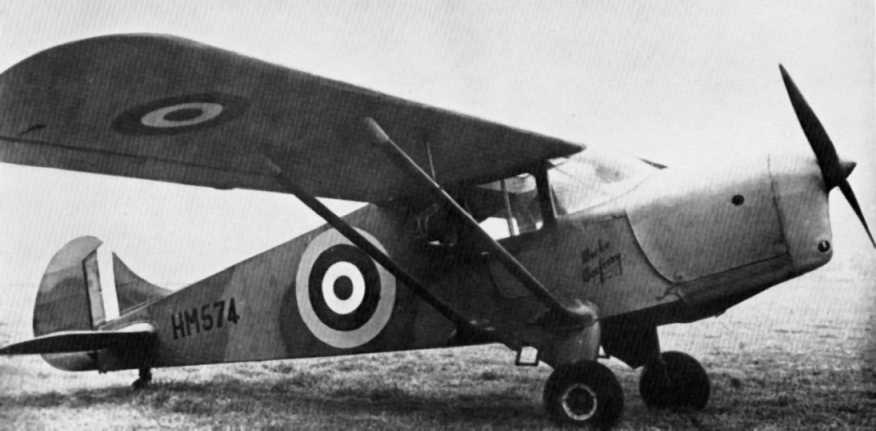
A little-known light aircraft; pressed into use in WW2.

One of the least-known of British aircraft companies, Foster-Wikner's GM1 was pressed into service during WW2. This is HM574, the example modified to "Warferry" configuration.
Young Australian engineer, Geoffrey Neville Wikner, after dabbling in motor racing, developed a passion for aviation and started up his own company in Australia in the early 1930s, designing and building a series of promising one-off aircraft and providing kits of parts to build gliders. A replica of his first "Wicko" single-seat "Sports-Cabin" aircraft, is housed at the Queensland Air Museum. The original aircraft was taken apart and redesigned twice by Wikner, first into the two-seat "Wicko Lion" and then into the much sleeker, low-wing "Wicko Wizard". Deciding that prospects for his talents were better in the UK (perhaps inspired by the success of his cousin Captain Edgar Percival) he wound up his fledgling company and moved to England in 1934. He worked on a series of projects for different concerns, most notably for the Miles company, where he had a hand in the design of the cockpits of the Hawcon and Nighthawk. He then did much of the design and actual construction of the little-documented Miles "pusher" aircraft of 1935-36. All this time Wikner was working towards establishing his own company to build his own designs; a false-start was a project to build a low-wing, two-seat racer with wire-braced wings and undercarriage for the racing driver Donald Marendaz. This was to be called the Marendaz "Special" monoplane, the "Special" name being the same as that used by Marendaz's racing cars. Wikner walked out of the project when Marendaz took all the credit for the design in his initial press release. Without Wikner, Marendaz was unable to finish the aircraft (with hindsight this was probably a lucky escape by Wikner because Marendaz acquired a notorious reputation for his business dealings and seems to have been a very unsavoury character).
Wikner then went into partnership with a Mr Victor "Jack" Foster to design and build a two-seat high-wing cabin monoplane to be powered by a Ford V-8 car engine. Foster introduced Wikner to the five Lusty brothers, who were looking for ways to diversify the family furniture-making business. They allowed the use of the family furniture factory, at Bromley by Bow in London, to be used to manufacture the prototype and as the registered address of the new company. The factory made the famous "Lusty Lloyd Loom" furniture, still going strong today, although the Bromley factory has long since closed and production moved to the Far East. The Lusty Brothers (Will, Arch, Jimmy, Frank and Harry) acquired the majority share of the new company, with Jim Lusty acting as Chairman.
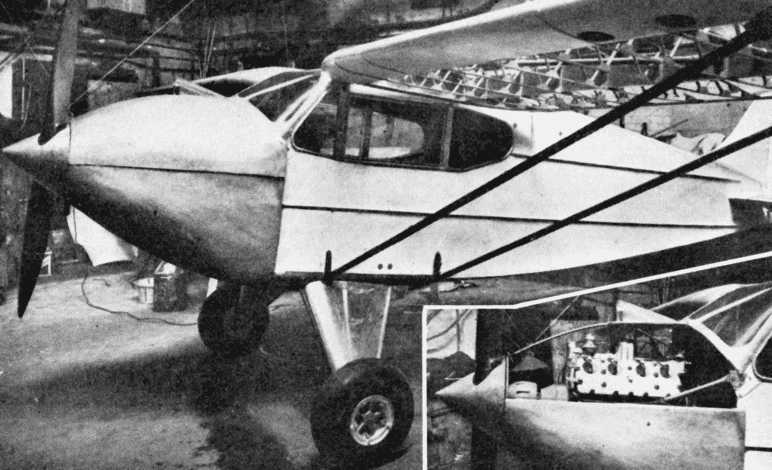
The FW1 pictured in the aeronautical press in July 1936, under construction in the Lusty factory in London. Inset is a view of the "Wicko F" adaption of the Ford V8 engine. There seems to be no radiator between the undercarriage legs at this stage. The accompanying text described the aircraft as having been under construction for 4 months and it was referred to as "The Wicko Monoplane". The article quoted a sale price of £375 with the Ford engine (which would rise to £425 when it was first advertised) but already anticipated the use of a Cirrus engine would put up the price to above £600. Rather prophetically, given later criticism, the article noted, "the view forward from the cabin is not particularly good".
At the time, there was a craze for trying to use low-cost motorcar and motorcycle engines to power aircraft. The Carden-Ford adaption of a four-cylinder Ford engine was proving very popular for single-seat home-built projects and it must have seemed logical to use the larger 8-cylinder engine on a more practical two-seat design. Wikner's adaption of the Ford engine used a Pobjoy reduction gear and was called the "Wicko F" and may have given as much as 80 horsepower, but was twice as heavy as comparable aircraft engines. The resulting aircraft was similar in basic layout to his original Australian cabin aircraft but had two side-by-side seats and was much sleeker, with the engine housed in a pointed nose with a radiator under the fuselage. It had a cantilever undercarriage like the latest Hawker Fury Mk II and Gloster Gladiator fighters. A contemporary magazine article said Wickner had been helped in the construction of the FW1 by Mr C.G. Durman and Mr D.W. Bishop.
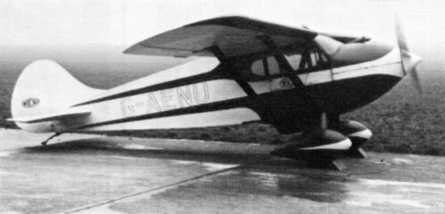
Looking very streamlined, the original FW1 (registration G-AENU), was powered by a modified "Wicko F" Ford V8 engine with a radiator between the wheels. It had fabric-covered wings. It made its first flight on the 21st of September 1936 from the airfield at Stapleford Tawney. When Wikner first outlined his design to the British aeronautical press he called it the "Wicko Wizard", the same as one of his earlier Australian designs. No doubt the existence of the Westland Wizard caused the change of name.
Called the FW1 (although early press releases called it the "Wicko Wizard", like Wikner's earlier Australian design) and registered as G-AENU, it gained the fledgling company a lot of publicity and press coverage but the Ford engine was heavy and performance was marginal. Then the Blackburn Aircraft company offered the loan of one of their Blackburn Cirrus Minor I engines of 82 horsepower¹. Fitted to G-AENU, it cut the weight of the aircraft down from 1,170 lb (534 kg) to 938 lb (425 kg). The resulting aircraft (renamed the FW2) was described as delightful to fly and the company went about marketing it (see the advertisement below) and acquired space at Eastleigh airfield, near Southampton, right next to the new Cunliffe-Owen factory, to start production. However, the change of engine had put up the advertised price of the aircraft from £425 to £650.
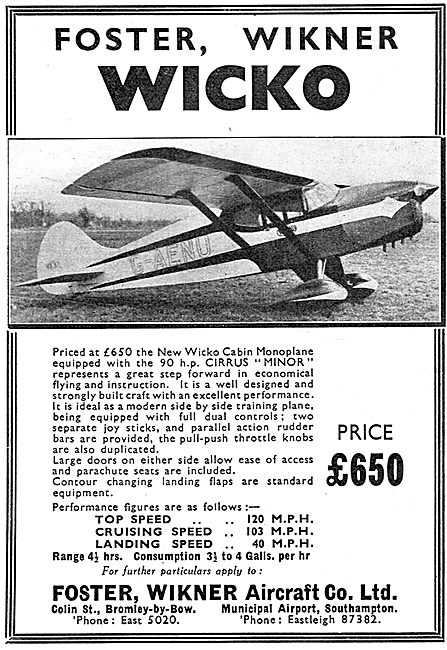
Above, is an advertisement for the Cirrus-powered FW2. None were sold in this configuration. It was photographed as late as 1952, the fuselage seemingly intact, by the side of the river in Plymouth <see picture on Air-Britain photo site>.
The next aircraft built by Wikner had the wing skinned in plywood rather than fabric and had the more powerful Cirrus Major engine of 150 horsepower. Originally called the FW3, it was evaluated by the A&AEE at Martlesham Heath in mid 1937, being criticised for its lack of wheelbrakes and elevator trimmer. It was entered into the Kings Cup Air Race of 1937 but did not complete the course after losing its propeller.² Wikner fell out with the Blackburn aircraft company over the air race failure, so he switched to the Gipsy engines of de Havilland. Wikner fitted the aircraft with a Gipsy Major I (srs I) of 130 horsepower¹. The new design was renamed after the engine - the GM1. Resubmiited for testing by A&AEE in February of 1938, this time fitted with wheelbrakes and elevator trimmer, the aircraft was judged to be a success, with a full certificate of airworthiness, including for aerobatics, being awarded in July of 1938.
Putting the aircraft through Air Ministry tests again had meant additional costs. This pushed up the price of a GM1 to just under £1,000, the same as more established, manufacturers like Miles and de Havilland. Wikner calculated that to make a profit from GM1 production he would need to order parts to build a batch of at least 25 aircraft, but his partners in the company only provided finance for 4 aircraft at a time. A simple, rugged design, the GM1 lacked some of the refinements customers expected, like folding wings to reduce hangar space. It had the minimum number of instruments and simple "plunger" type throttle controls, rather than throttle-quadrants. Its range of 500 miles was greater than many other aircraft of this class but as a touring aircraft, the GM1 was a non-starter, with no dedicated luggage compartment, just a small shelf on top of the fuel tank behind the two seats. So the only real role for the aircraft was as a club trainer. In this regard, the timing could not have been better. The Civil Air Guard scheme had recently been formed and started operating the very month the first GM1 was delivered. This subsidised the training of civilians to fly if they volunteered to serve in the armed forces in wartime, rewarding them with a sizeable grant (worth about three times the average monthly pay at the time) if they gained their flying licence. Thus there was a demand for two-seat training aircraft in the exact class of the GM1 and a couple were sold for this use. The sale of one Wicko GM1 was secured to an engineering company in New Zealand.
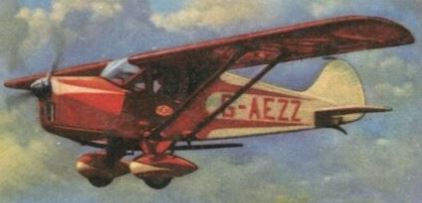
Contemporary collector's card illustration of the Wicko. They were all initially delivered in an eye-catching "strawberries and cream" colour scheme.
Sales then trailed off and there was pressure to close down the company. However Wikner persevered, his biography states he redesigned the aircraft to have detachable wings, which cut down hangar storage space and meant the aircraft could be more easily shipped overseas to try to lure foreign buyers. At the same time, slight dihedral was added to the wings, wider elevators were fitted and a horn balance was added to the aircraft rudder to improve handling. Just which aircraft off the production line had these changes is hard to pin down. Photos of G-AFKK, the 7th production GM1 (company construction number 8) show it had dihedral and a horn balance. These changes were not undertaken lightly, since the company had to pay to have the design recertified to be safe to fly with the new configuration, which added to the overheads of the already floundering business.
In use, the main criticism of the Wicko GM1 was the restricted view from the cockpit, especially for taxiiing. The plunger throttle controls were also an issue. Both pilot positions had their own plunger control directly in front of them, essentially just a rod with a knob on the end, sticking out of the instrument panel. It was left up to the individual pilot which hand they used to operate the throttle. This did not prepare trainee pilots well for the traditional throttle quadrants used on other aircraft.
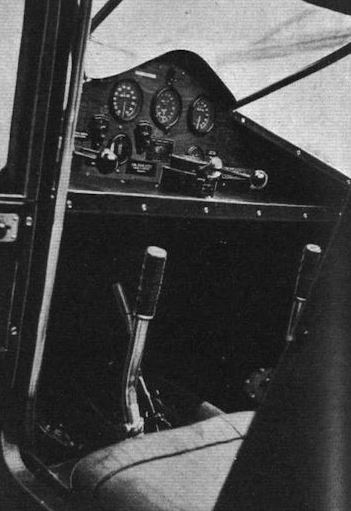
The cockpit of the Wicko GM1, showing the plunger-like throttle controls that stuck out from the instrument panel. There was a shelf in front of the panel with a compass located centrally on it. Between the two control columns is the handle to operate the flaps.
In all, eight Wicko GM1 aircraft were completed and sold before the start of the war in September 1939, when all production of civil aircraft was ordered to be halted. Wikner was left with two unsold and unregistered Wicko GM1 aircraft.
Before the war, Wikner had also designed a simple tandem training aircraft with a wire-braced, low monoplane wing. It looked similar to the American Ryan PT-22 but made of wood rather than metal. He presented it to the Air Ministry with the idea of it being produced in Australia to be used in the British Commonwealth Air Training Plan. It was not taken up, the CAC Wackett trainer filling the niche for an Australian aircraft in this class perfectly. Wikner also designed a similar tandem aircraft with an enclosed cockpit for potential civil use, to be called the "Windsor", again this came to nothing.

G-AFJB, the last surviving Wicko GM1.
The plastic fairings to streamline the joints of the wing struts of the Wiko GM1 were provided by a company called Plastilume. The acetate sheets to manufacture these components were made by the British Celanese chemical company. The Celanese company approached Wikner to ask if he would like to buy the raw material directly to make the components himself. Wikner quickly devised and built machinery to mould the sheets into plastic components for aircraft. This turned out to be much more lucrative than building whole aircraft. The company moved out of the hangar at Eastleigh and into cheaper factory accommodation nearby (a lucky move because Eastleigh airfield was badly damaged by bombing early in the war).
Shortly after the start of WW2, Wickner joined the Air Transport Auxiliary (ATA). He left the company in the hands of his wife and it continued to produce plastic parts for British aircraft throughout the war. Wickner served as an ATA ferry pilot from April 1940 until November 1945. He flew 67 different types of aircraft and carried out 1,164 delivery flights. He was badly injured in the crash of a Hawker Typhoon on the 19th of March 1943 but recovered and returned to flying duties after 4 months. In May 1944, he survived another crash landing, this time in a Fairey Barracuda after an engine failure. He was awarded a commendation for an incident in August 1944 when he successfully landed a Lancaster with all four propellers defective.
The ATA had the use of Avro Ansons for transporting large numbers of ferry pilots as well as a miscellany of twin-seat types, including some impressed Wicko GM1 aircraft, for delivering single pilots. However, in mid-1941, Wickner became aware of the need for an intermediate type of small aircraft to deliver two or three ferry pilots economically. He became convinced the GM1 design could be modified to fill this role and managed to convince the ATA to give him time off to investigate the possibilities.
From one GM1 he removed the second set of pilot controls and fitted extra seats in the rear. This meant the fuselage metal fuel tank had to be removed and replaced by smaller fibre tanks mounted inside the wings. Extra stiffening was added under the door openings. The wing struts were lightened, which meant the aircraft would have been restricted from doing aerobatics. In photos, an additional small strut can be seen between the wing and leading support. The flaps were deleted, it was felt that the landing run was short enough without them. It had a tail wheel instead of a skid. It was first tested as a four-seater but it was cramped and with the weight of four people aboard performance was marginal. So it was modified to be a three-seater with the rear passenger sitting sideways. It was allocated the military registration HM574 and evaluated at Boscombe Down. It was intended for the name "Warferry" to only be used for the three-seat version, but after Wikner got some coverage for the project in the aeronautical press, including a listing for the Warferry in the authoritative "Aircraft of the Fighting Powers" book, the name started to be applied to all GM1 aircraft. Wikner felt he was close to getting a production order but after Pearl Harbour the range of aircraft available from the USA under lease-lend greatly expanded and the four-seater Fairchild 24 Argus was supplied to the ATA instead.
Shortly after the start of WW2, Wickner joined the Air Transport Auxiliary (ATA). He left the company in the hands of his wife and it continued to produce plastic parts for British aircraft throughout the war. Wickner served as an ATA ferry pilot from April 1940 until November 1945. He flew 67 different types of aircraft and carried out 1,164 delivery flights. He was badly injured in the crash of a Hawker Typhoon on the 19th of March 1943 but recovered and returned to flying duties after 4 months. In May 1944, he survived another crash landing, this time in a Fairey Barracuda after an engine failure. He was awarded a commendation for an incident in August 1944 when he successfully landed a Lancaster with all four propellers defective.
The ATA had the use of Avro Ansons for transporting large numbers of ferry pilots as well as a miscellany of twin-seat types, including some impressed Wicko GM1 aircraft, for delivering single pilots. However, in mid-1941, Wickner became aware of the need for an intermediate type of small aircraft to deliver two or three ferry pilots economically. He became convinced the GM1 design could be modified to fill this role and managed to convince the ATA to give him time off to investigate the possibilities.
From one GM1 he removed the second set of pilot controls and fitted extra seats in the rear. This meant the fuselage metal fuel tank had to be removed and replaced by smaller fibre tanks mounted inside the wings. Extra stiffening was added under the door openings. The wing struts were lightened, which meant the aircraft would have been restricted from doing aerobatics. In photos, an additional small strut can be seen between the wing and leading support. The flaps were deleted, it was felt that the landing run was short enough without them. It had a tail wheel instead of a skid. It was first tested as a four-seater but it was cramped and with the weight of four people aboard performance was marginal. So it was modified to be a three-seater with the rear passenger sitting sideways. It was allocated the military registration HM574 and evaluated at Boscombe Down. It was intended for the name "Warferry" to only be used for the three-seat version, but after Wikner got some coverage for the project in the aeronautical press, including a listing for the Warferry in the authoritative "Aircraft of the Fighting Powers" book, the name started to be applied to all GM1 aircraft. Wikner felt he was close to getting a production order but after Pearl Harbour the range of aircraft available from the USA under lease-lend greatly expanded and the four-seater Fairchild 24 Argus was supplied to the ATA instead.
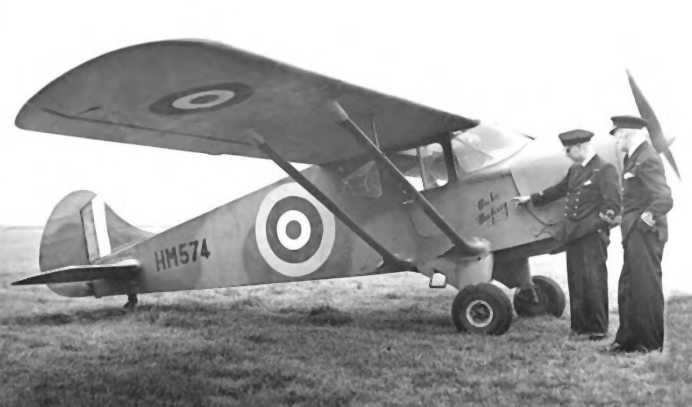
The Wicko Warferry, registration number HM574. Notice the horn-balanced rudder and what appears to be an additional thin strut from the wing to the main forward strut.
Just which GM1 was converted into the 3-seat "Warferry" prototype is open to debate. Some sources claim it was G-AFKS and say that it was that aircraft that was impressed as HM574, yet pre-war photos of G-AFKS clearly show it without a balanced rudder while HM574 has a horn balanced rudder. Wikner stated in his biography that the Warferry was modified from one of the unregistered aircraft left in his hands when war was declared. Research by a team from Air-Britain, published in the Spring 2008 edition of Air-Britain Archive magazine, shows that the Warferry was, in fact, the airframe with construction number "10", stored during the first year of the war. This is confirmed by one of Wikner's old logbooks.
All the registered GM1 aircraft were requisitioned by the authorities (including one that had been sent to New Zealand). Some were used by the ATA, mostly with No 1 Ferry Pilot Pool based at the airfield of White Waltham near Maidenhead, west of London. The other major user of GM1 aircraft was number 24 Communications Squadron based at Hendon and Northolt on the outskirts of London. At one stage 24 Squadron had three on strength; they relinquished their Wickos for deHavilland Puss Moths in August 1942 (the Puss Moth was usually flown as a two-seater with space for baggage but could be used as a three-seater if required). Other Wicko GM1s were used in a communication role by RAF station and Group flights. In wartime service the Wickos usually had their wheel spats removed; they would become clogged up with mud and grass and had to be removed quite often anyway to service the brakes, so it was easier to just leave them off altogether.
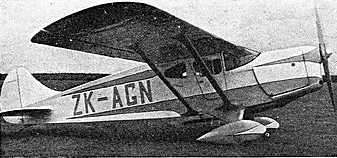
One Wicko GM1 was shipped out to New Zealand where it was registered as ZK-AGN. It was impressed into the RNZAF in October 1939 as NZ580. It was used for communication duties based out of Rongotai (now Wellington International Airport). In November 1942, during bad visibility, it struck a radio mast at nearby Johnsonville and crashed. Luckily there were only minor injuries to the crew. The aircraft was recovered to Rongotai but broken up for spare parts before the end of the year.
Before the War, Wikner's relationship with his business partner, the erratic Jack Foster, had deteriorated into open hostility. Foster had tried to get the Lusty brothers to switch their support to another low-cost light aircraft project designed by a Mr Richard Taylor. Sadly, Taylor lost his life when the prototype crashed on its third flight due to a design failure. The Lusty brothers ended up buying out Foster's share of the company. The company was listed as "Wicko" (rather than Foster-Wikner) in "Jane's All the Worlds's Aircraft" in 1945, with its works at Eastleigh and its admin office still at the Lusty Lloyd Loom factory in Bromley by Bow. Wilkner was still listed as the technical director with three members of the Lusty family as directors, together with a Mr Norman Edgar (a close friend of Wikner who also served in the ATA). When the war ended, the lease for the plastic factory building was going to be uneconomic to renew so the company was wound up. Wikner had become homesick for his native Australia and made plans to return, at first planning to purchase a yacht for the voyage home but then deciding to find a way to fly himself and his family back.
After the war, some of the Wicko aircraft came back into the possession of Wikner. His original plan was to use two of them to fly his family (wife and two small children) back to Australia. He combined the airframes of the last two production GM1s to produce G-AGPE, which was registered in April 1946. His plans for the Wickos were changed when he managed to obtain a Halifax bomber! Wickner sold all his Wickos to Phillippa Bennet, a wartime ATA pilot, who intended to set up a small aircraft taxi business. In May 1946, Wikner flew back to Australia in the Halifax, with 19 passengers and crew (a total of 20 including Wikner). Read the full remarkable story at <this link>.

Wicko GM1 DR613 (G-AFJB) pictured in the garden of Ken Wooley. You can appreciate how the raked-back windscreen, low seating position and high nose of the GM1 made forward visibility poor when taxiing.
Within a few years of the war ending, only Wicko G-AFJB survived in flying condition. It was used as an air taxi by Phillipa Bennet, during which time it suffered a fall over an 80ft (24 metres) cliff to land upside down in the sea. Repaired, it was then used by Phillipa Bennet and Lettice Curtis in numerous air races. It then passed through the hands of various owners until it fell into disrepair at Bagington Airfield near Coventry. It was rescued by Ken Wooley who kept the aircraft in his garden for many years. It was purchased in 1998 and restored to flying condition by Joe Dible and Ken Souch.
In retrospect, the Wicko GM1 was too slow to be a racer, did not have the accommodation to be a tourer, its plunger throttles were too idiosyncratic and the cockpit visibility was too poor for it to be a good trainer while the price had risen too high for it to appeal to those who just wanted the cheapest way to own their own aircraft.
Wicko GM1 Specifications
Max Speed: 140 mph (225 kph) at 1,000 ft (305 metres). Cruising Speed: 120 mph (193 kph) at 1,000 ft (305 metres).
Range: 500 miles (805 km). The 3 seat version would have had less fuel giving about half the range.
Span: 31ft 6 inches (9.6 metres). Length: 23ft 8inches (7.21 metres) Height: 6ft 1inch (1.85 metres).
Max Speed: 140 mph (225 kph) at 1,000 ft (305 metres). Cruising Speed: 120 mph (193 kph) at 1,000 ft (305 metres).
Range: 500 miles (805 km). The 3 seat version would have had less fuel giving about half the range.
Span: 31ft 6 inches (9.6 metres). Length: 23ft 8inches (7.21 metres) Height: 6ft 1inch (1.85 metres).
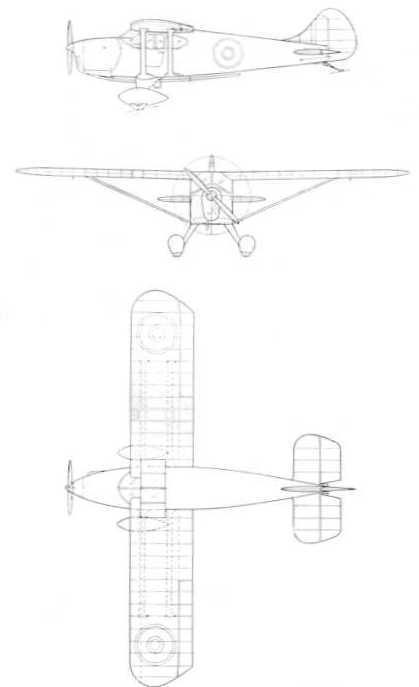
General arrangement of the Foster-Wikner GM1. Note that they often operated with the undercarriage spats removed. This diagram shows the rudder with a horn balance.
List of Foster-Wikner production.
For a more detailed listing see the Spring 2003 edition of Air-Britain Archive magazine.
For a more detailed listing see the Spring 2003 edition of Air-Britain Archive magazine.
Construction number: 1. FW1/FW2. Built with a fabric-covered wing and no flaps. Registered as: G-AENU. Originally Wicko F engine, then Cirrus Minor. The Cirrus engine was loaned for free by the Blackburn Aircraft company for a 12 month period and was returned to them. It was never issued a Certificate of Aviation (Cof A) prior to the war and flew under an "Authorisation to Fly" certificate meant only for testing of prototype aircraft. The airframe was stored during the war but then reappeared with a full CofA in 1946. It passed through the hands of various owners. Last photographed in 1952, by the side of the river Plym in Plymouth.
Construction number: 2. FW3/GM1. Registered as: G-AEZZ. Originally fitted with a Cirrus Major engine. When first built it had no wheelbrakes or elevator trimmer. Evaluated by A&AEE in August 1937. It was entered for the King's Cup Air Race of 1937, flown by Flt Lt HRA Edwards. It did not complete the race, force-landing near Skegness.² Re-engined with a Gipsy Major and fitted with wheelbrakes and elevator trimmer to become the first GM1. Retested in this configuration by A&AEE in February 1938. Used by the Cardiff Aeroplane club before being impressed in July 1941 as ES925. It was used by the ATA , based at White Waltham. Struck off RAF charge in September 1942 and reduced to scrap.
Construction number: 3. GM1. Shipped directly to New Zealand. Registered as: ZN-AGN. Initially used by Clyde Engineering, then sold to the Middle Districts Aero Club. Impressed into NZ Air Force as NZ580. Used for communications work. Written off after collision with aerial mast (no fatalities) 26/11/1942. Broken up for spare parts and salvage.
Construction number: 4. GM1. Registered as: G-AFAZ. Purchased by the Bristol and Wessex Aeroplane Club at Whitchurch for the Civil Air Guard scheme. Impressed as ES924 in May 1941. Used by the ATA at White Waltham. Broken up for spares August 1942.
Construction number: 5. GM1. Registered as: G-AFJB. Purchased for the Midland Aero club specifically for use in the Civil Air Guard Scheme. After war was declared it was used by Rolls-Royce for communications work. Impressed as DR613 in July 1942. Used by ATA at White Waltham. Had a taxiing accident in July 1942, it was repaired and based at Heston airfield for a time. Then used as a communication "hack" aircraft by Cunliffe-Owen at Eastleigh (the airfield where it had been built). Put into storage at Kemble at the close of the war before being aquired by Wikner who sold it on to Phillipa Bennet. The sole surviving Wicko GM1, its full history is told on <this webpage> on the Wicko.com website.
Construction number: 6. GM1. Registered as: G-AFKS. Used as a demonstrator by Nash Aircraft Sales Ltd, who were agents for Foster-Wikner. It was briefly fitted with a ski undercarriage during the winter of 1938/39. Impressed by the RAF but allocated directly back to Wikner and not given a serial number. Its C of A lapsed in January 1940. Probably broken up for spares by Wikner. Registration cancelled in 1946 when a census of British aircraft found no trace of it.
Construction number: 7. GM1. Registered as: G-AFKU. Sold to Mr Frank L Dean of Cardiff. Impressed as ES947. In September 1941 it suffered some sort of damage that required it to be returned to Cunliffe-Owen at Eastleigh for repair. Used by 24 Sqdn RAF from April 1942 until August 1942. Then used by Northolt station flight. Crashed into sea near Cardiff in November 1942 after hitting a barrage balloon cable. The aircraft was returning to Northolt with two Czech pilots onboard after attending the funeral of another Czech pilot. Passenger killed, pilot seriously injured. - See full accident report at <this link>.
Construction number: 8. GM1. Registered as: G-AFKK. Built with detachable wings that incorporated modest dihedral and a horn-balanced rudder. It required testing at A&AEE to certify the new configuration. Impressed as ES913 in May 1941 and used by ATA at White Waltham. Used by Wikner for two days in October 1941 for testing in overloaded conditions in conjunction with "Warferry" development. Used by 24 Sqdn RAF from June 1942 until August 1942. Scrapped in December 1942.
Construction number: 9. GM1. Registered as: G-AFVK. Impressed as HM499 in October 1941. Used by ATA at White Waltham, then at RAF Cranwell for use by No 1 Signals School and then 27 Group (signals training) communications flight. Collided with lorry when taxiing (at RAF Leeming?). Reclassified as a non-flying instructional airframe: 4962M. Allocated to Air Training Corp No 1457 Sqdn at York in December 1944. No photo found to confirm if it had dihedral or a horn balance.
Construction number: 10. GM1. Never registered before the war. Stored for early part of the war. Modified to be the "GM2" Warferry, with first flight 18th December 1941. Photos show it to have a horn-balanced rudder. Tested by the Royal Aircraft Establishment (RAE) in January 1942. Impressed as HM574 in June 1942. May have been used briefly for ATA duties from White Waltham but essentially remained in the care of Wikner, stored at Eastleigh for the remainder of the war (confirmed in his biography). Advertised for sale by Wikner in early 1946 and sold to Philippa Bennet for use for spare parts.
Construction number: 11. GM1. Impressed directly as HM497. Used by 24 Sqdn RAF until August 1942. Then used by 93 Group communications flight and 27 OTU at RAF Lichfield. Then used by 81 OTU at Tilstock until December 1943. Stored at 5 MU RAF Kemble from November 1943. Survived the war, purchased back by GN Wikner and collected from Kemble in June 1945. Perhaps refurbished with parts from other GM1 aircraft owned by Wikner. Registered as G-AGPE in April 1946. Sold on to Phillipa Bennet in April 1946. Photos show it had a horn balanced rudder and was fitted with a tailwheel rather than a skid. Scrapped in May 1949.
NOTES
¹ I've taken the power ratings of the Cirrus Minor I and Gipsy Major I from Lumsden's " British Aero Engines And Their Aircraft".
² The Kings Cup Air Race had a tragic accident that year. See <this link> for details.
LINKS

The Wicko.com website has the most exhaustive history of the Wicko available on the internet along with details of the restoration of G-AFJB.
YouTube video of a flight in Wicko G-AFJB
Foster Wikner Wicko on Wikipedia.

The Wicko.com website has the most exhaustive history of the Wicko available on the internet along with details of the restoration of G-AFJB.
YouTube video of a flight in Wicko G-AFJB
Foster Wikner Wicko on Wikipedia.
This website devoted to Australian aircraft has a good article on the Wicko, but the records of individual aircraft are somewhat muddled and disjointed (August 2021).
Aviation Safety website report on loss of ES947 (ex G-AFKU).
Article about Wikner on the Australian Newcastle Herald website (paywalled access).
A very brief view of Wicko G-AEZZ can be seen in this old cine-film of the Shoreham Air Show of 1937. It appears 2 minutes and 11 seconds into the film.
Biography of Wikner on the "A Fleeting Peace" website. It contains details of his service with the ATA and the Halifax flight to Australia.
A Gallery of photos of Wicko G-AFJB on the Southport & Merseyside Aero club website.
Photos of Wicko GM1 aircraft (mostly of G-AFJB) on the Air Britain Photo Library.
Sources
The most exhaustive and authoritative technical source on Wikner's designs is a series of four articles in Air-Britain Archive Magazine. The Summer 2002 edition covered Wikner's Australian designs, the Autumn 2002 edition covers the FW1/2 prototype, the Winter 2002 edition covers GM1 production and service and the Spring 2003 edition has an exhaustive history of all Wikner's British production. The author of the first three articles was Jack Meaden, while the final production list is a collaboration by Jack Meaden, Malcolm Fillmore, Bernard Martin, Jim Halley and Trevor Broughton. An earlier one-page article in the Spring 2002 edition discusses Wikner's association with Marendaz, which itself is a follow-on from an article in the Winter 2001 edition about the Merendaz "Special".
The Wicko story: An article in the April/June 1980 edition of Vintage Aircraft magazine (No 16) written by Geoffrey Wikner himself.
Flight of the Halifax - The Biography of Captain GN Wikner, Australian Pioneer Aviator: More of an autobiography than a biography because it is written in the first person from notes left by GN Wikner, edited by Norman Mitchell. Published by KV Wikner (GN Wikner's son) 1993. ISBN: 0646 11353 4.
The Foster-Wikner Wicko: An article by Francis Donaldson with excellent colour photographs by Simon Fenwick and Owen Watts in the December 2011 edition of Light Aviation magazine. It has a brief history of the Wicko GM1 with an extended description of the restoration of G-AFJB with brilliant descriptions of the aircraft's structure and cockpit and what it is like to fly.
British Civil Aircraft 1919-59 (Volume 2): By AJ Jackson, published by Putnam.
British Light Aeroplanes: By Arthur JG Ord-Hume, published by GSM Enterprises, ISBN 10 1870384768. Particularly good at untangling Wikner's association with Marendaz.
Aircraft of the Fighting Powers Volume IV (1943): The way the aircraft is described implies only the modified 3-seater should be called the "Warferry".
Humping the Bluey in Waltzing Matilda: An article in the September 1979 edition of Aeroplane Monthly magazine by Geoffrey Wikner describes the extraordinary adventure of flying Halifax G-AGXA from England to Australia with 19 passengers and crew (20 including Wikner). The whole article can be read on the Wicko.com site <click here>.
The Aircraft Flown by 24 Squadron: A document on the website of the 24 Squadron Association Blog. Compiled from squadron records.
Aircraft Manufacture in West Essex: A document on the website of the North Weald Airfield Museum (the prototype FW1 was built in Bromley by Bow which was classed as Essex at the time).
Aeroplane Monthly Magazine - April 2022 Edition, has an article on Wikner and the Wiko GM1 by Arthur JG Ord-Hume. Unfortunately, the article lists G-AFKS as the aircraft converted to be the "Warferry", seemingly unaware of the research by Air-Britain that identified it as the aircraft with construction number "10" that never received a civilian registration before the war.
"British Flight Testing - Martlesham Heath 1920-1939": By Tim Mason, first published by Putnam in 1993. ISBN 0 85177857 7.
Aviation Safety website report on loss of ES947 (ex G-AFKU).
Article about Wikner on the Australian Newcastle Herald website (paywalled access).
A very brief view of Wicko G-AEZZ can be seen in this old cine-film of the Shoreham Air Show of 1937. It appears 2 minutes and 11 seconds into the film.
Biography of Wikner on the "A Fleeting Peace" website. It contains details of his service with the ATA and the Halifax flight to Australia.
A Gallery of photos of Wicko G-AFJB on the Southport & Merseyside Aero club website.
Photos of Wicko GM1 aircraft (mostly of G-AFJB) on the Air Britain Photo Library.
Sources
The most exhaustive and authoritative technical source on Wikner's designs is a series of four articles in Air-Britain Archive Magazine. The Summer 2002 edition covered Wikner's Australian designs, the Autumn 2002 edition covers the FW1/2 prototype, the Winter 2002 edition covers GM1 production and service and the Spring 2003 edition has an exhaustive history of all Wikner's British production. The author of the first three articles was Jack Meaden, while the final production list is a collaboration by Jack Meaden, Malcolm Fillmore, Bernard Martin, Jim Halley and Trevor Broughton. An earlier one-page article in the Spring 2002 edition discusses Wikner's association with Marendaz, which itself is a follow-on from an article in the Winter 2001 edition about the Merendaz "Special".
The Wicko story: An article in the April/June 1980 edition of Vintage Aircraft magazine (No 16) written by Geoffrey Wikner himself.
Flight of the Halifax - The Biography of Captain GN Wikner, Australian Pioneer Aviator: More of an autobiography than a biography because it is written in the first person from notes left by GN Wikner, edited by Norman Mitchell. Published by KV Wikner (GN Wikner's son) 1993. ISBN: 0646 11353 4.
The Foster-Wikner Wicko: An article by Francis Donaldson with excellent colour photographs by Simon Fenwick and Owen Watts in the December 2011 edition of Light Aviation magazine. It has a brief history of the Wicko GM1 with an extended description of the restoration of G-AFJB with brilliant descriptions of the aircraft's structure and cockpit and what it is like to fly.
British Civil Aircraft 1919-59 (Volume 2): By AJ Jackson, published by Putnam.
British Light Aeroplanes: By Arthur JG Ord-Hume, published by GSM Enterprises, ISBN 10 1870384768. Particularly good at untangling Wikner's association with Marendaz.
Aircraft of the Fighting Powers Volume IV (1943): The way the aircraft is described implies only the modified 3-seater should be called the "Warferry".
Humping the Bluey in Waltzing Matilda: An article in the September 1979 edition of Aeroplane Monthly magazine by Geoffrey Wikner describes the extraordinary adventure of flying Halifax G-AGXA from England to Australia with 19 passengers and crew (20 including Wikner). The whole article can be read on the Wicko.com site <click here>.
The Aircraft Flown by 24 Squadron: A document on the website of the 24 Squadron Association Blog. Compiled from squadron records.
Aircraft Manufacture in West Essex: A document on the website of the North Weald Airfield Museum (the prototype FW1 was built in Bromley by Bow which was classed as Essex at the time).
Aeroplane Monthly Magazine - April 2022 Edition, has an article on Wikner and the Wiko GM1 by Arthur JG Ord-Hume. Unfortunately, the article lists G-AFKS as the aircraft converted to be the "Warferry", seemingly unaware of the research by Air-Britain that identified it as the aircraft with construction number "10" that never received a civilian registration before the war.
"British Flight Testing - Martlesham Heath 1920-1939": By Tim Mason, first published by Putnam in 1993. ISBN 0 85177857 7.
This webpage was revised with new information in January 2024.
